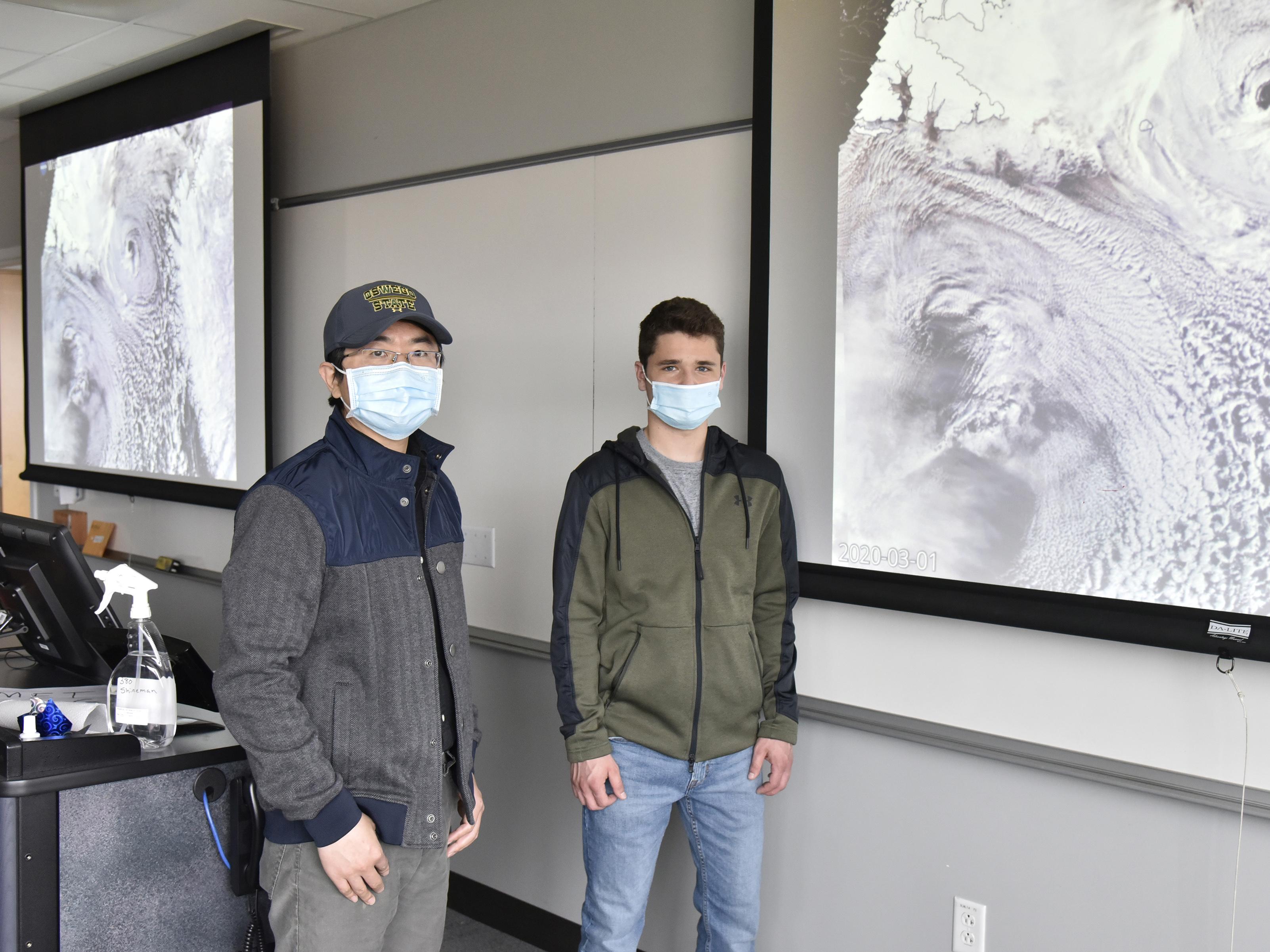Atmospheric and geological sciences faculty member Yonggang Wang (left) and sophomore meteorology major Michael Pagnanelli recently earned a campus grant to support their research of Arctic cold air outbreaks.
While the SUNY Oswego family is well aware of what lake-effect snow is, a recent campus grant will enhance federal funding for student-faculty research on a more large-scale effect involving Arctic air.
Junior meteorology major Michael Pagnanelli and atmospheric and geological sciences faculty member Yonggang Wang earned a Student Scholarly and Creative Activity Grant for “Climatology of Arctic Cold Air Outbreaks – An Observational Analysis.”
This study is part of a larger research project that also includes meteorology major Madeleine Crean, who earned the same grant in fall 2020 for a proposal on “Characterizing and Understanding Cloud Streets in Arctic Cold Air Outbreaks.”
“A cold-air outbreak is generally in the Arctic areas of the world, when an air mass of very cold air moves southward in the northern hemisphere or northward in the southern hemisphere away from either pole,” Pagnanelli explained. “And when that very cold air moves over the ocean, if it's unfrozen, you get convective clouds, and its precipitation is what we're observing.”
Pagnanelli, who was drawn to Oswego for its research and hands-on opportunities, compares it to the all-too-familiar lake-effect snow pattern.
“With lake-effect snow, you have a relatively warm lake, and you have a really cold air mass moving over the lake that can kick off precipitation,” Pagnanelli noted. “It's due to that temperature difference, when you have colder air higher up and a warm surface temperature with the water being relatively warm. In this research, it's basically the same idea with lake-effect snow, but it’s a much larger scale.”
Climate research
Pagnanelli was in Wang’s climatology class and learned about the ongoing research, funded by the U.S. Department of Energy, titled “Mixed-phase Convective Clouds in the Polar Marine Boundary Layer.” The work, which Wang began several years ago had funding he transferred to Oswego from his previous institution, Texas Tech University.
“I have been researching Arctic cold-air outbreaks for years, and the grant transferring to Oswego helps support my students,” Wang said. “For example, we are going to talk about what we might be able to present in conferences and what publications we can pursue.”
The research is of interest to Wang -- as well as student researchers and others in the field -- because the Arctic climate has a large impact on the world’s weather, as anybody who has heard Oswego alumnus and NBC “Today” show weatherman and co-host Al Roker talk about the polar vortex would know.
“The connection of the weather and climate between the pole areas and mid-latitudes, from the cold Arctic air to the warm air from the equator, is an important one,” Wang said. “When they have some interaction, we have some interesting weather, for example, the mid-latitude cyclones that will lead to the lake-effect convection under suitable atmospheric and lake conditions.”
Despite the large impact Arctic air has on the world’s weather, not much research is devoted to it.
“The scarcity of just data in the Arctic also interests me a lot as well because you don't have weather stations every other block, like you do with much of the world,” Pagnanelli said. So they are working with datapoints from such locations as Bear Island, Norway, that have the instruments to get good measurements.
Gaining experience
The ultimate goal of the research is to gain a further understanding of Arctic cold-air outbreaks and document their climatology using the rich datasets collected from the Cold-air Outbreaks in the Marine Boundary Layer Experiment (COMBLE), but in addition to the practical benefits of understanding this better, the project provides irreplaceable experience for student researchers.
“My primary goal in coming to Oswego was the opportunity to work with undergraduate researchers,” said Wang, who still advises graduate students at other universities. “I want to include undergraduate students in my research projects because I enjoy teaching in the classroom, but to expose them to research opportunities is so important.”
The larger project also includes Oswego meteorology majors Ethan Weisberger and Matthew Rolph. The opportunity for students to work in teams, as well as with colleagues from other universities, is valuable as well, Wang said.
During the research project, Pagnanelli and Crean also are learning the programming language Python. “Python is a major tool in meteorology and it’s becoming even more important,” Pagnanelli said. “I do some work for the National Weather Service and they always say knowing Python looks great on any resume.”
For that work, Pagnanelli is among around 15 students who work for the meteorology program’s Lake Effect Storm Prediction and Research Center, which uses its observations to inform local and regional partners what to expect during the winter to inform their decision-making.
“During the winter, I work Fridays for the center, and this research connects with that,” Pagnanelli said. “The process of lake-effect snow is similar to these cold-air outbreaks so it's definitely helpful with that as well.




